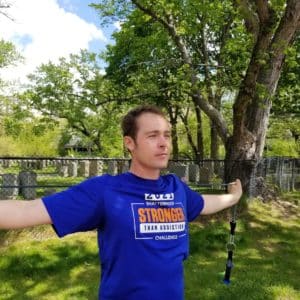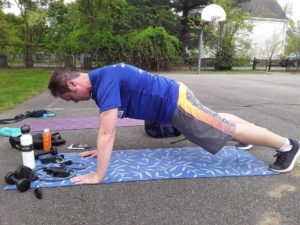TNP Provides New Student Supports
Introduction:
The NAN Project is proud to offer a new program to the community, SEL Circles (Social-Emotional Learning Circles). It is a six-week, in-school, curriculum-based program made for groups of up to 15 students. The program is supported by The NAN Project’s licensed mental health clinician/school counselor, Peer Coordinators, and Peer Mentors.
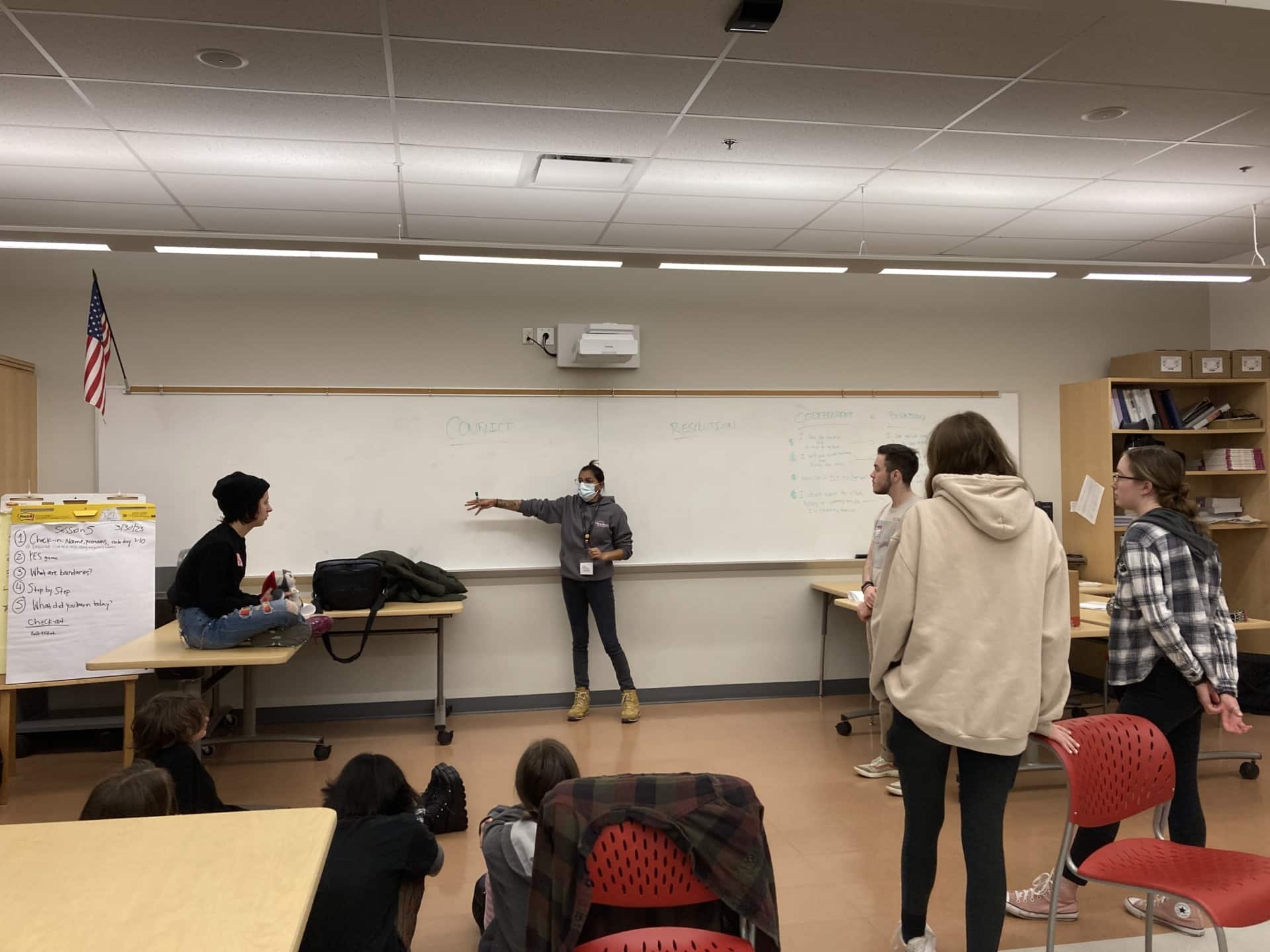
Sarojini Schutt, Peer Coordinator, facilitating a discussion at Galvin Middle School SEL Circles about managing peer conflict
SEL Circles were created due to community providers, educators, and parents noticing changes in the youth they serve–many are more anxious than prior to the pandemic, and have had trouble creating connections with their peers, and looking for programming that could be helpful.
Recent Statistics About Youth Mental Health:
Recent data supports what educators and caregivers have noticed. The CDC’s Youth Risk Behavior Survey collects self-reported surveys from high school students across the United States every two years. The most recent data from 2021 shows that compared to 2019, more high school students are feeling sad or hopeless in a way that impairs their everyday activities (33.8% vs 38.5%), and more students seriously considered attempting suicide (17.5% vs 18.4%). Additionally, out of all US high school students surveyed in 2021, 29.3% reported their mental health was either not good most of the time or not good all of the time, and 38.5% reported they either didn’t feel close to people at their school or weren’t sure.
SEL Circles Curriculum:
SEL Circles are designed to help middle school- and high school-aged youth gain a greater understanding of the warning signs of mental health challenges, the supports that are available to them, ways to help a friend who may be struggling, and coping strategies to deal with their mental health. SEL Circles are not a substitute for or form of therapy. The goal of SEL Circles is to create a safe place where kids can gather and learn new skills related to emotional regulation, active listening, and coping strategies through a trauma-informed lens. By the end of the six week program, youth will have learned more about mental health and how to identify, communicate, and express emotions in a healthy way. The curriculum is offered in a format that is fun, educational, and appealing for students who can benefit from a little extra social-emotional support.
The topics covered in SEL Circles curriculum may include Orientation & Connection, Building Self-Esteem, Managing Reactions to Stress, Mindfulness, Active Listening, Bound
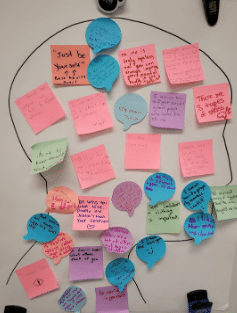
Galvin Middle School students participating in SEL Circles provided colorful feedback.
ary Setting/Managing Peer Conflict, and Reflection & Application. Educators and staff who would like to bring SEL Circles to their school will have the opportunity to discuss the needs of their students with The NAN Project’s School Counselor, Liza Tierney, and tailor the curriculum as needed.
Response From Students:
To date, The NAN Project has facilitated three cohorts of SEL Circles, at the Eliot Family Resource Center in Everett and at Galvin Middle School in Wakefield. The NAN Project staff collected survey data from SEL Circles participants on the first session and on the last session to learn more about what youth are taking away from sessions.
At Galvin Middle School before SEL Circles began, only 50% of the participants self-reported that they knew of coping skills to deal with difficult emotions. On the last day of the program, 80% of students either agreed or strongly agreed that they knew of coping skills to help with difficult emotions. There was also an increase in the pre- and post- survey data regarding the percentage of students who reported they had at least one adult they could speak to about a difficult situation (83% on the first day, compared to 100% on the last day).
When asked what they learned at SEL Circles, students said:
“Conflict doesn’t always have to be negative.”
“I learned good ways to cope with anger and stress”
On the most useful thing youth learned at SEL Circles:
“The 3 Rs [Regulation, Reflection, and Relaxation].”
“How to calm yourself and also that your [sic] not alone.”
“Learning about stress management.”
“That not being OK is OK when you ask for help.”
“I know many things to do when I am sad.”
This spring, The NAN Project is excited to be providing SEL Circles at Thurgood Marshall Middle School in Lynn and Phoenix Academy in Lawrence, in addition to continuing their partnership with Galvin Middle School. To discuss bringing SEL Circles to your school or community, email [email protected].
Our First College Peer Mentor Training & A Peer Mentor Update
Introduction:
Thanks to grant funding from the MA Department of Higher Education, we recently conducted our first college peer mentor training at Massasoit Community College (MCC) in Brockton, MA. This training not only marked a significant milestone for us, but also was a great success. With the collaboration of Violet Akoh, MCC’s Health & Wellness Coordinator, and the leadership of Erica Tangney, TNP’s College Outreach Coordinator, we engaged numerous students through on-campus outreach, ultimately training six new peer mentors. This partnership with Massasoit has opened doors for us to expand our programming into Massachusetts’ Southeast Region.
Successful Peer Mentor Training:
During the training at MCC, our team provided instruction on how to write a Comeback Story, enhance and practice their public speaking skills, and ways to safely speak to youth about mental health. By the end of training, each student had written a powerful story of lived experience. The NAN Project is immensely proud of these peer mentors and all the work they put into the training!
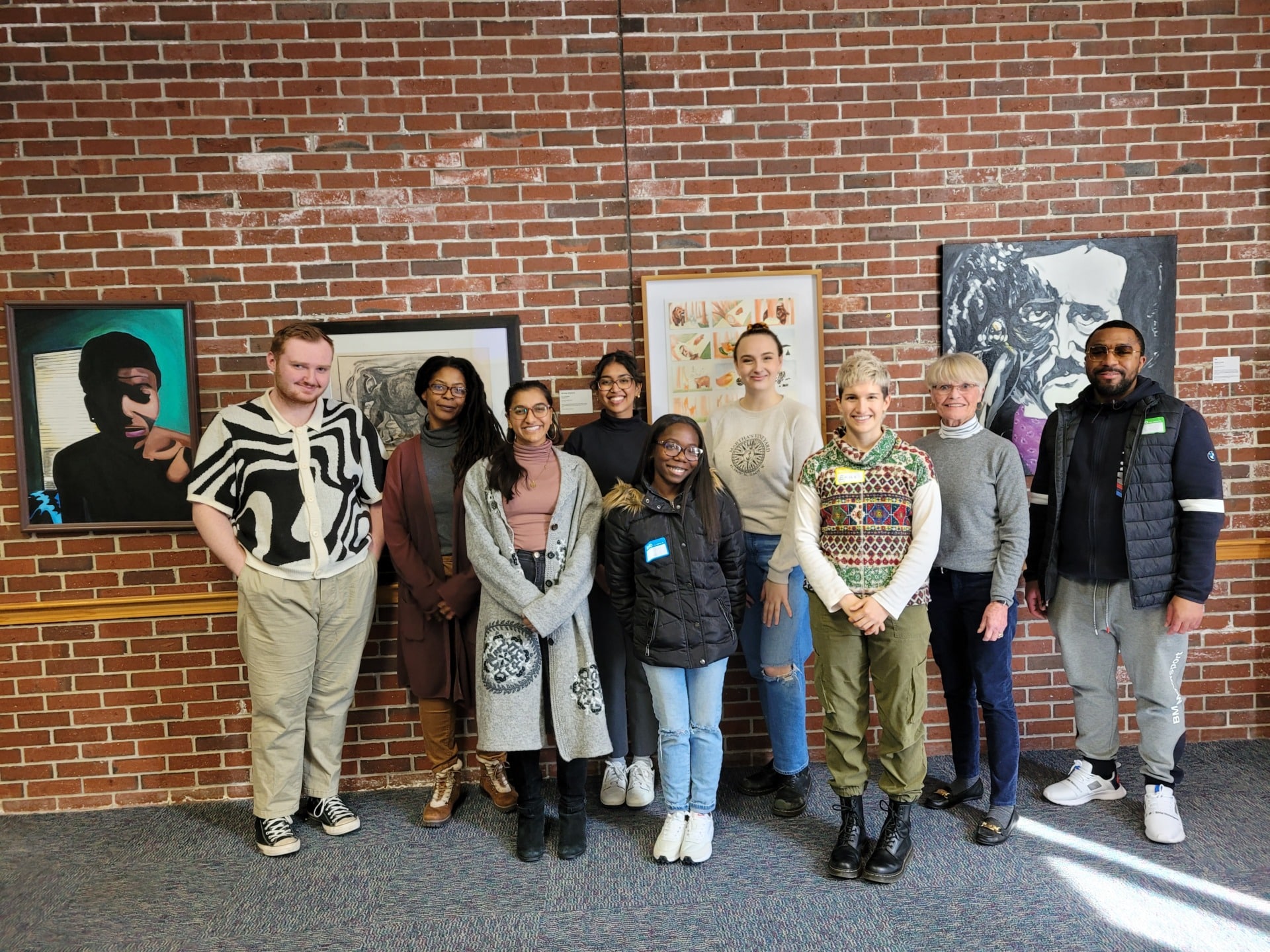
Peer Mentors and TNP Staff at Massasoit CC Training Graduation.
Continued Growth:
Following the training program at Massasoit CC, we have continued efforts to expand our network of peer mentors. An additional four peer mentors have completed our training and have already started attending presentations! We continually hire peer mentors on a rolling basis in order to bring as many presentations to students as possible.
Upcoming Training in Lynn, MA:
As we continue to expand our outreach efforts, we are excited to share that our staff is actively preparing for another training. This time, we will be hosting a training program in Lynn, MA over the summer. We have many community and school partners in the Greater Lynn area. By hiring more peer mentors, we hope to provide more robust programming to Lynn public schools and to strengthen these relationships.
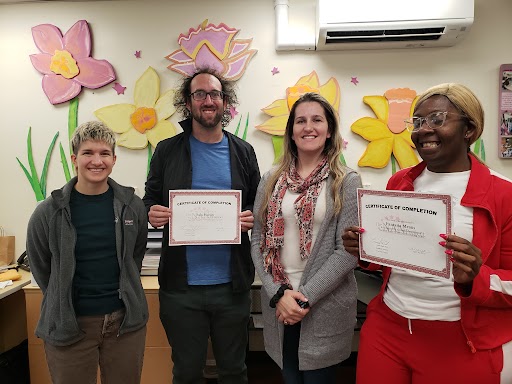
Our Newest Peer Mentor Cohort and TNP Staff.
Final Thoughts:
We are so grateful for MCC and all the peer mentors who work with us. We look forward to holding many more peer mentor training opportunities in the community or in institutions of higher education! For information about our partnerships with colleges and universities, contact Erica at [email protected]. If you are interested in the peer mentor role, please contact Shilpa at sthirukkovalur@thenanproject.
The NAN Project Highlights Resources for Black Youth
On February 10th, 2023, The Center for Disease Control released “Notes from the Field: Recent Changes in Suicide Rates, by Race and Ethnicity, and Age Group – United States, 2021”. The data shows suicide rates increased by 19.25% during 2018-2021. For persons aged 10-24 suicide rates showed a worrying increase and, more specifically, among black youth aged 10–24 years, the rate of suicide increased 36.6% during 2018–2021. We highly recommend reading this report which can be found here: https://www.cdc.gov/mmwr/volumes/72/wr/mm7206a4.htm.
The overall message we gather from this research is that suicide continues to be a public health issue, and continues to be an increasing threat to black youth across the country.During this Black History Month, we highlight three resources we rely upon to continue our education in pursuit of racial justice, inclusion, and suicide prevention for black youth across Massachusetts.
 ★The Steve Fund: https://www.stevefund.org/
★The Steve Fund: https://www.stevefund.org/
During our Peer Mentor presentations, we distribute resource cards that can fit inside a wallet or behind a phone case. We tell students to carry them everywhere they go so they can be prepared with a plethora of mental health resources for themselves or a friend at any time. On this card, we have The Steve Fund.
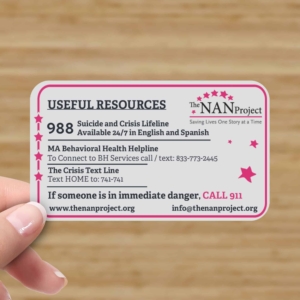
Front of Resource Card
The Steve Fund is the nation’s leading organization for young people of color with the overarching goal of creating a “robust national dialogue” centered on young people of color and their mental and emotional health and well-being. The Fund has a plethora of resources through their “Knowledge Center” located on their website. During our presentations, we highlight the Crisis Text Line service that connects young people of color to a culturally competent crisis counselor. Just text STEVE to 741-741 and someone will be on the other line in no time! The Steve Fund has partnered with the Crisis Text Line to provide this service 24/7, meaning any time of day or night a young person can reach out with questions about their own mental health, a friend’s health, and/or if they have general questions about mental health.
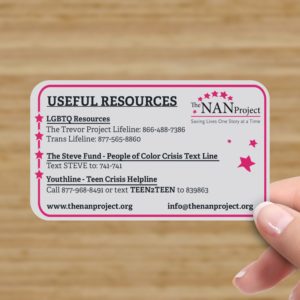
Back of Resource Card
The Fund also has a podcast “Speak On It!” that you can find at this link: https://www.stevefund.org/speakonit/. The podcast brings students and professionals together to discuss topics related to mental health and the challenges that Black, Indigenous, and People of Color may face during their academic and professional careers. We cannot recommend The Steve Fund enough!
 ★ National Queer and Trans Therapists of Color Network: https://nqttcn.com/en/
★ National Queer and Trans Therapists of Color Network: https://nqttcn.com/en/
The National Queer and Trans Therapists of Color Network describes themselves as: “a healing justice organization that actively works to transform mental health for queer and trans people of color in North America”. Since May 2016, NQTTCN has been building a network of mental health practitioners as well as a Mental Health Fund for those in need of financial assistance. The Founder, Erica Woodland, created this organization as a call to mental health practitioners to deepen their understanding of healing justice and create communities of care with, and an understanding for, Queer and Trans People of Color (QTPOC). They share resources for organizations seeking to uplift QTPOC communities through healing justice initiatives. A unique feature offered through their website is a directory of practitioners that you can search by region. And, if you are a therapist or provider that identifies as a QTPOC and are a licensed mental health professional, you can fill out an online application to become part of the directory! The directory can be found here: https://nqttcn.com/en/mental-health-directory/. The NQTTCN is doing invaluable work for communities of Queer and Trans people of color who are at unique risk of violence and suicide. Please check them out and support their work if you can!
★Year Up: https://www.yearup.org/
Year Up is an organization striving to “close the “Opportunity Divide” by ensuring young people gain the skills, experiences, and support that will empower them to reach their potential through careers and higher education”. Year Up offers a three step program that allows young people to work closely with expert instructors to gain career-building knowledge while being in close contact with a team of support to ensure success and offer mentoring along the way. Supporting young people start and advance in their careers while being assisted by a mentor creates protective factors; factors that contribute to a person’s ability to maintain their mental health and reduce their risk of suicide. Being part of a community that wants to see them succeed, creating financial stability, and inspiring hope for the future has been proven to prevent suicide. Year Up’s program “Black Opportunity Alliance” creates a platform for Black philanthropists to help cultivate the future of black leaders. With 35% of Year Up’s young people are black, having the support of older, Black business-people and philanthropists encourages and financially supports a younger generation of black youth to achieve their career goals. You can find more information on the program here: https://www.yearup.org/blackopportunityalliance.
We are inspired by Year Up’s unrelenting commitment to diversity, equity, inclusion, and belonging. Creating a focus on these key themes contributes to the longevity of youth in this program and their future success. Read more about it here: https://www.yearup.org/about/commitment-to-diversity. Check out Year Up and support them in whatever way you can! Supporting this organization means supporting black youth pursuing their career goals and building hope for the future!
We have gathered three amazing resources that we utilize to inform our work and create a world where all are able to thrive and create hope for the future. But the list does not end here! What resources do you use to educate yourself and continue the work of destigmatizing mental health challenges? Share them with us! It is our responsibility as stewards in the field of mental health and in destigmatizing mental health to maintain a racial and intersectional lens.
Our team is committed to educating and raising awareness in order to amplify voices that are both historically and too often underrepresented, denied, and disbelieved.
School Counselor Spotlight – Liza
Please join us in welcoming our first School Counselor, Liza Tierney! Liza joined The NAN Project in September 2022. She is bringing over 20 years of experience working with students to connect with students and staff in classrooms we visit. Erica, our College Coordinator, interviewed Liza for our School Counselor Spotlight!
A Q&A with Health Educator Holly Breen
Earlier this year, we spoke to longtime Andover High School health educator Holly Breen about the impact of the pandemic on students’ mental health and the ways The NAN Project helps. She shares her unique perspective in a Q&A here.
“It’s OK to Leave” – Living with a Mental Health Challenge Vignette
“It’s Okay to Leave” written by John Oxenford with Illustrations Designed by Alison Sabean
The following vignette is about a person who is experiencing symptoms from their mental illness, but is nevertheless able to persist, and manage their mental health challenges. Voice 1 represents the character’s fears that limit them from being able to accomplish their goals that day. Feelings and struggles, similar to those that this person is experiencing from their mental illness (Voice 1), can drive someone towards suicidal thinking. Thoughts like these can inhibit a person from being able to live a stable life, due to their consistent fears and repetitive irrational thoughts. The thoughts that this character is experiencing stem from a reasonable place, such as, wanting to ensure everything is set in a person’s home before they face the day, however, in this character’s case the thoughts are exaggerated out of proportion, and thus become invasive and limiting. Even though this person has checked all of the things that they needed to check, thoroughly and efficiently, in order to be able to start their day, their fear is still there and thus creating an intrusive barrier, causing them to assume that for some reason what they have done is not enough. Voice 2 represents the part of the protagonist’s mind that is uninhibited by their unsubstantiated fears and doubts, in other words their rational mind. The conversations happening between the protagonist and their voices represent an internal struggle many people with mental health face on a regular basis, as they work to manage their mental health. I hope this scene gives hope to people who are going through similar struggles – and might even be experiencing suicidal thoughts. This scene was created to give hope, and the understanding that struggles can be overcome.
It’s OK to Leave
Characters:
Girl, early 20s
Voice 1 representing Girl’s negative thoughts
Voice2 representing Girl’s positive thoughts
Scene:
A small apartment. It is simply furnished but immaculate. Everything in its place, not a speck of dust. Music plays through stereo speakers mounted on the bookcase.
Girl is packing her backpack for the gym. She puts a water bottle in the outside pocket, then checks each pocket. She puts the pack down and goes into the kitchen. She walks slowly round inspecting all the appliances—toaster, fridge, microwave. Stops at the stove, checks that each dial is set to off, checks each burner to make sure it’s cold. She does this several times, then stops, takes a breath.
Girl [as if about to do a parachute jump]: OK, ready to go.
She walks to the door. Her hand is on the knob. She’s about to turn it when–
Voice 1 (offstage): Haven’t you forgotten something?
Girl: Um . . . No?
Voice 1: What about the stove? You forgot to check the stove.
Girl [less certain]: No, I’m pretty sure I checked it all.
Voice 1 enters upstage right. The stage lights begin to dim.
Voice 1[sinister, slightly threatening]: Well I’m pretty sure you missed something. Check again!
Girl [moving toward the kitchen]: I—I thought I checked it. I thought I checked it really well.
Voice 1: You thought? But you’re not sure. What if there’s a fire. Do you want to take that risk? They’d evict you. People could be killed. Check again. Properly this time.
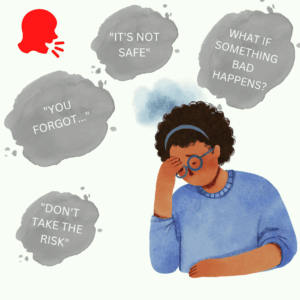
Illustration designed by Alison Sabean
Girl goes over to the stove, repeats the checks she did before but takes much longer. Visibly nervous.
This interchange is repeated several times, until the girl, now very stressed, runs to the door, grabs the knob, turns it.
Voice 1: Are you really going? You’re willing to take the risk? What if—
The lights flicker. Sound of glass shattering, a siren, people running and shouting.
Girl: [screams] Stop! Stop! Leave me alone!
Voice 1 disappears. She drops onto the couch, head in hands.
Voice 2 enters upstage left. A faint light shows.
Voice2: Why are you sitting there? I thought you were going to the gym today.
Girl: I can’t.
Voice 2: Why not?
Girl: Because—I don’t know. It just doesn’t feel . . . safe.
Voice2: Safe? How do you mean?
Girl: What if I went out and I’d left a burner on and there was a fire? They’d evict me. People could be killed.
Voice2: But how could there be a fire? You checked the stove. Every burner. Lots of times. The stove is fine.
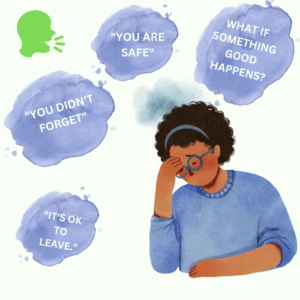
Illustration designed by Alison Sabean
Lights begin to come up. Girl sits up, looks around her, as if seeing her apartment for the first time. Takes a breath. Laughs.
Girl: The stove is fine! I checked it! Lots of times!
She gets her backpack, walks straight to the door, leaves without a backward glance.
Voice1 enters.
Voice1: Have you checked the—
Sees there’s no one there
Lights out.
The NAN Project Celebrates Hispanic Heritage Month 2022
Written by Karla Flores and Mia Celeste Sheets
Cesar Chavez, the Mexican American labor leader and civil rights activist, said, “preservation of one’s own culture does not require contempt or disrespect for other cultures.” As we celebrate Hispanic/Latinx Heritage month in 2022, we not only uplift unique cultures, but we also want to take the time to recognize these cultural differences and what that may mean for the mental health of those in the Hispanic and Latinx communities. Hispanic Heritage Month takes place from September 15 to October 15 honoring the histories, cultures, and accomplishments of American citizens with ancestors who came from Central and South America, the Caribbean, and Spain. The observance was born in 1968, under President Lyndon Johnson and was expanded by President Ronald Reagan in 1988. It was enacted into law on August 17, 1988, with the approval of Public Law 100-402.
September 15 is significant as it is the anniversary of the five Latin American countries Costa Rica, El Salvador, Guatemala, Honduras, and Nicaragua. Both Mexico and Chile celebrate their independence on September 16 and September 18. It’s important to understand there is great diversity within this community, where people are connected by shared cultural values regardless of race, ancestry, or national origin. The identities and diverse cultures within the Hispanic and Latinx communities are as rich and complex as their history. Typically, those who identify as Latino, Latina, Latine, or Latinx may consider themselves of Latin American descent (Central America, South America, or the Caribbean), and those who identify as Hispanic may be referring to ancestry from Spain or other Spanish-speaking countries. While the two terms may share overlap, not everyone believes these terms can be used interchangeably to mean the same thing and will instead refer to their country of origin instead of as “Hispanic” or “Latinx”, however, members of the population may use different terms interchangeably.
Through Mental Health America research, over 18.3% of the U.S. population is estimated to be Latinx or Hispanic, which is about 62.1 million people in the United States. Of those, over 16% reported having a mental illness in the past year. That is over 10 million people, more than the number of people who live in New York City! Hispanic Heritage Month also overlaps with September’s Suicide Prevention Awareness Month and October’s Depression Awareness Month, so here at The NAN Project, we wanted to take this opportunity to extend the dialogue surrounding mental health within the Hispanic and Latinx communities. Similar to the way Hispanic culture creates a unique environment for members of the population to show strength and resilience, there are also specific barriers to gaining access to mental health support like financial and language barriers, access to insurance, legal status, lack of cultural competency, stigma, and machismo. These aspects are particular to Hispanic and Latinx culture, which we’d like to recognize, discuss, and provide resources that are working to overcome these barriers.
Financial barriers can affect anyone’s ability to access mental health treatment. According to a research article concerning residents of Washington Heights, New York City, where the population is 67.9% is Hispanic or Latino, “those who experienced financial barriers to mental health care had significantly higher depressive symptoms in comparison to those who could afford mental health care” (Pabayo R et al Financial Barriers to Mental Healthcare Services and Depressive Symptoms among Residents of Washington Heights, New York City. Hispanic Health Care International). We know that one factor that impacts financial access is access to health insurance. One in four Latinos do not have health insurance, and while the Affordable Care Act has narrowed racial gaps in access to healthcare, Latinos are still nearly 3 times more likely to be uninsured than non-Hispanic whites. Many are not aware of the Affordable Care Act eligible for children of undocumented immigrants they can access, and individuals without legal status may not seek or register for mental health services due to fear of separation or deportation, an adding a barrier to access to care.
For those who do have financial capabilities to seek professional mental health care, there may be difficulty in finding a provider who understands them either linguistically, culturally, or both. According to Census data, there are only about 5,000 psychologists in the United States who are Hispanic, representing less than 6 percent of all psychologists. In a nationwide APA survey, only 5.5 percent of psychologists, who may be Hispanic or of another race or ethnicity, said they can provide services in Spanish, making them a rare commodity. In addition, only 6.4% of therapists in the United States are Hispanic or Latinx. Symptoms, as they are described in the Hispanic and Latinx communities, can often be misunderstood by mental health providers or lead to a misdiagnosis of individuals as they have their language as well as differences in beliefs, lifestyles, and customs. A common example is how the word “nervios” in Spanish can be used to describe physical illness and can be symptoms of depression but a mental health professional can still misdiagnose them by misunderstanding this word to describe symptoms of anxiety (NAMI website).
Seeking mental health treatment requires acknowledging that there is a need to do so, which can present its own challenge to members of the Hispanic or Latinx community, due to added stigma surrounding mental health challenges within the community. When it comes to discussing symptoms and recognizing mental health challenges, these can be hard to identify, because Latinx/Hispanic people will often focus on physical symptoms and not psychiatric symptoms during doctor visits. This can also be because there is a common perception in Latinx/Hispanic communities, especially among older people, that discussing problems with mental health can create embarrassment and shame for the family, resulting in fewer people seeking treatment. It can be hard to shift an entire community’s temperament and would require these beliefs to be challenged over time. This is most prevalent amongst older generations due to a lack of acculturation. The level of a person’s acculturation is how thoroughly they have embraced or adopted the predominant culture of the place they live, which can play a role in mental health and access to care. Acculturation has been found to predict an increased willingness to use mental health care services between first and second-generation immigrants from various cultural backgrounds.
Despite this, according to SAMHSA’s National Survey on Drug Use and Health, overall mental health issues are on the rise for Latinx/Hispanic people between the ages of 12-49. Major depressive episodes increased from 12.6 percent to 15.1 percent in Latinx/Hispanic youth ages 12-17, from 8 percent to 12 percent in young adults 18-25 age range between 2015 and 2018. This reinforces the importance of increasing access and creating more dialogue around mental health that does not create further stigma but instead normalizes the discussion and encourages seeking treatment for mental health challenges.
Mental health stigma has many layers in the Hispanic community, one of which is known as machismo. The term “machismo” has been described as the belief that you must be able to provide for your family despite any pain or hardship the man endures. Latino men even go to the extremes of avoiding going to the doctor because it is seen as a sign of weakness. In a study, one Latino man said, “[In] machismo we are taught that the men always had to be strong. . . The man doesn’t cry, the man is the provider of the family, the man shouldn’t complain, and the man doesn’t go to the doctor.” Similarly across many minority and immigrant communities, there is a phenomenon known as the “Eldest Daughter Syndrome” that is extremely prevalent amongst the first-born daughters of immigrants. The high pressure to succeed in an environment different from their parents and set a good example for their younger siblings, can lead to anxiety, depression, and other mental health challenges. Some feel burdened with the responsibility of taking care of their younger siblings and at a very young age they adopt more of a maternal role in their family system, adding stress to their critical developmental stages of life.
Despite these obstacles and challenges, the Hispanic/Latinx community continues to show strength and resilience. This year’s theme in celebrating Hispanic Heritage is Unidos: Inclusivity for a Stronger Nation. Here at The NAN Project, we also recognize these barriers and are actively trying to provide support to overcome them. We work with schools, organizations, and people in the community to educate and bring awareness surrounding mental health. We recognize that inclusivity doesn’t just look like bringing equal access to resources to various communities, but also identifying what one specific community’s needs are and understanding what we can offer to fill those needs. By bringing our work, support, expertise, and resources to schools and community centers that are predominantly Hispanic, the goal is to bridge the gap between mental health and what it means to be part of the Latinx community. Understanding how they correlate to each other is the first step in improving on the lack of access and stigma that prevents people from seeking the treatment they need.
Please visit The NAN Project website for a Resource Guide regarding Mental Health Resources hotlines with trained operators who are available 24/7 to help you find support.
Also, check out local organizations here in Massachusetts working closely with our Hispanic/Latinx communities!
- La Colaborativa is a human services organization in Chelsea that provides social services and programming to Latinx immigrants like language courses, career training, citizenship support, and distributes food to families in the communities. https://la-colaborativa.org/
- Eliot Family Resource Center (FRC) in Everett supports families with youth who are at-risk of needing court involvement because of their behaviors. FRC helps families find resources regarding housing support, education, utility assistance, legal help, summer camps, sports leagues,and more. https://www.eliotchs.org/family-resource-center/
- UTEC in Lowell helps young adults through street outreach, violence intervention, programming at correctional facilities, social reintegration, transitional coaching, workforce development, mental health services, and more. https://utecinc.org/
- CTI YouthBuild of Greater Lowell helps young adults between the ages of 16 and 24 who have dropped out of high school and provides opportunities like G.E.D. preparation, vocational training, one on one case management, leadership development, life skills training, and career and academic coaching.
- Roxbury YouthWorks INC helping youth struggling with victimization, poverty and violence transition successfully into adulthood. Services provided are bringing to commercial sexual exploitation of children, work with law enforcement, child-serving public agencies, and other non-profits to help reintagrate youth from court-ordered detention and treatment facilities back into society. http://www.roxburyyouthworks.org/
- The Boston Alliance of LGBTQ Youth (BAGLY) is a youth-led, adult-supported social support organization, committed to social justice and creating, sustaining, and advocating for programs, policies, and services for the LGBTQ+ youth community. https://www.bagly.org/
- YouForward in Lawrence and Everett supports young adults ages 16 to 25 who are experiencing mental health challenges through mentoring, achieving goals, and helping discover talents and use it to inspire others. http://youforward.org/
- The Center for Hope is a Rape Crisis Center in Lowell with a goal to deliver multicultural and inclusive approaches to reach those who have historically have not been adequately served (i.e. limited English speakers, LGBQ/T folks, refugees and immigrants, children, youth, people with disabilities, etc) and also provide different programs for survivors as well as youth prevention groups. https://chhinc.org/
My Fitness and Mental Health Journey
Hello everyone, my name is John Joshua William Oxenford, and I work for The NAN Project as a Lead Peer Mentor – I’ve been working with TNP since August of 2020, and find that it gives me (and all of us involved) a platform to give help to people who are struggling with mental illness. The NAN Project helps me reconnect with my acting skills while presenting my own personal story of crisis and recovery. I have been acting since I was eight years old, and have been in a few plays (around 2008-2009) including The Boys of Winter at The Boston Playwrights’ Theatre and Romeo & Juliet for the New Art Theatre in New Hampshire. Music is another huge element in my life. I have my own solo project in the metal genre, and I am looking to expand into other genres by collaborating with other musicians. I just got my very first demo recorded at Chillhouse Recording Studio, and am trying to reach out to other musicians to play with. But my main focus in my life, and something that connects very closely with my mental, physical, emotional–and even spiritual–stability, is fitness! In this story I will discuss how fitness was (and is) a main focus in my life, and how it changed and evolved throughout my life until now; and mainly, how it positively effects and supports my mental health (as well as my physical, emotional, and spiritual health, which in my opinion are all closely connected).
My first form of fitness was soccer. My mother got me involved with Cambridge Youth Soccer at age eight, and I started as a defender on the ‘Ebony’ team; I remember the first time I kicked a soccer ball in a game; the ball came rolling to me, none of the other kids were near – I thought, “What should I do?”– and I made the decision to run up and kick the ball as hard as I could! And that’s when soccer started being a huge part of my life.
My next team was ‘Ivory.’ I was playing with a lot of higher skilled kids, and did what I could when I was on the field, but I didn’t do much. In the last quarter of the season, our extremely supportive coach made it his dedication that my friend and I would each score our very first goal. Believe it or not, before the season was over, we both did! It gave me the idea and understanding that through setting goals and having support from others to accomplish them, one can complete seemingly unreachable ambitions. What a motivation to keep playing my favorite sport.
‘Sky Blue,’ my next team, was a completely different experience… we were losing every game, by massive goal differences. However, even from ‘Sky Blue’ I had a learning opportunity. It must have been one of the last games of the season. All of my teammates had stopped playing, and were literally just standing still (who could blame them?). The other team was kicking the ball around effortlessly, bringing the game to a close… Even though it seemed the match had come to a close, I had not stopped trying. I chased the ball as fast as I could and yelled at my teammates, “Come on guys! It’s not over yet!” And even though they didn’t seem to take any notice, I learned something about myself that day… I am not someone who easily gives up.
Today, as we at TNP present to schools, I remember that moment in my life, and search to convey that life experience to students who might be going through a similar time as I did. Even though I could have seen that game as another hopeless loss, I gave all that I could until the very end; it reminds me of times in my life when I didn’t feel like there was any hope for me; that memory, of not giving up, helps and has helped me know that there is light at the end of the tunnel, and there is hope – sometimes you just have to wait it out until it arrives. And even though that season of seemingly endless losses didn’t feel good, it gave me some emotional and mental endurance, for when I was on other teams, that some players had never been through. This endurance is important for me when accomplishing my fitness goals, and something that I carry with me through other challenges in my life.
In high school, I was a starter as a defender, on my school’s, Cambridge Rindge and Latin (CRLS), soccer team, and later transitioned to midfield. Trying out for the team was a heavy challenge, where we had to complete 12 laps on the field’s track (the center field at Danehy Park, that CRLS used for home games and most of the time for practice) in a short amount of time. Even after making the team, the new requirements for midfield were another challenge. Midfield required me to keep my head up and aware, to pass to my teammates as well as still play defense if my team needed it. This required new effort, but it also gave me new self esteem, as I was able to accomplish new challenges that seemed daunting to me at first. Being on this team, from Freshman to Junior year, was exciting, and brought on an event, in my Sophomore year, which is now my favorite memory of playing soccer.
I was a starter in a game, playing midfield, and the ball came to me, and I looked up, seeing that I had some time; I was at the half field line, and found some comfort in kicking the ball a few paces, thinking about what I should do… All of a sudden, I felt an inspiration to kick the ball, and I just let that feeling guide me as I gave everything I had at that moment to kick the ball. I saw it leave my foot, and it soared far over all of the other players and curled smoothly into the upper left side of the other team’s goal, as their keeper dove as far as he could to try to stop the goal. That experience helps me find hope and confidence in myself when I am going through moments of depression or low self esteem, when I feel like I can’t do anything good enough or it’s just not worth trying. I think it is important for people to make note, and remember, those moments in their lives, when they did something that helped them feel good about themselves, when they accomplished something that made them feel really proud – especially when combatting moments of sadness or hopelessness.
And yet, something changed during my senior year of high school. I think it was mainly through my increasing use of substances – that I’d done to try and socialize and have fun and feel confident with other kids – that really brought me down. I became isolated and angry, and doubtful of even my family and friends. Out of nowhere, I decided to stop playing soccer – my only source of fitness. It wasn’t all terrible… I joined the dance club, and was able to perform for the school in their modern dance performance; I was still playing music with friends, and even writing my own songs; I was also winning awards in acting competitions. However, another result of my symptoms, which now I am certain came from substance abuse, was that I decided not to join the school’s theatre department in that year’s play, the play that they were taking to the Massachusetts High School Drama Guild’s Theatre Competition (something that, since Freshman year, had been a main point of every year for me). My symptoms were taking over, and I began to become skeptical of everyone around me, antisocial, introverted, and angry.
This only increased during my first year of college, and led me quickly to make a decision to drop out. I wasn’t playing soccer, and I wasn’t exercising in any way. I tried my skills in the professional acting world, but dropped out of that too. I stopped communicating with friends and family, and, all of this doubt in the world and anger of things not going my way and lack of trust in people who could have helped me, led me to attempt suicide. The first thing I remember, after waking up in hospital, is seeing my mom; and that was a very appropriate experience, because it was mainly through her advice and encouragement that I began to incorporate fitness into my life, again, in other ways.
After my recovery in hospital, I began living in a group home in Somerville, MA, and was just beginning to put my life together again, more independently this time. I began to trust my mother (again) and we regained our close bond that we’d had before I began substance abuse. She advised me to get a membership at a gym, and I began to research gyms that were close to where I lived. It took a few years of trying out different gyms, with different locations, different trainers, and different vibes and environments… Eventually I found a gym that was, appropriately, in the same building as the Mass Rehab building that I was going to to look for work and train for job interviews – just a 10 minute walk from where I was living. I got some lessons with a trainer there that helped me get comfortable with the gym, as I began to decide what workouts I wanted to incorporate into my routine. I started to feel like a real gym goer, and so I also began to acquire the feeling of being in another community, one that was focused solely on physical health. However, I was still trying to find the correct medications for me, and thus was going in and out of hospitalizations. The decision I made after my final release from hospital, was a milestone in my fitness lifestyle.
With the exception of “Fresh Air,” time (when we were taken outside for an hour twice a day, in a fenced off area, to shoot some hoops and get a breather) I was stuck indoors for about a month. My mother was very worried about me not getting any exercise, so, she bought me some pushup rotation handles – and even bought a treadmill for the ward! So, I became accustomed to counting out some pushups, when I felt like it, and getting a good 20-30 minute fast walk when the inspiration called. So, it was out of hospital, after my last hospitalization, with my medications finally set in a way that was comfortable for me, that I began to make some consistent fitness goals for myself to accomplish. Every day, I did 10 pushups, and jogged to the bridge and back (about 30 minutes). And, I did this routine, practically every day without fail, for a year. Once I got comfortable with that routine, I added 5-10 more pushups, and jogged a little bit further, on the Boston esplanade (about 45 min).
It was around then that I began working as a cleaner for Boston Sports Club, and later, Boston Racquet Club. Through being immersed in the gym experience, and seeing other people’s routines, and experimenting with different workouts, I found my own routine. Now, I write down a percentage of how much I worked out every day; with my main routine being, given enough time, 4 sets of 10 pushups, 2 sets of 10 situps, 2 sets of 10 crunches, and a 30 minute jog on the treadmill. I also do some cardio on the row machine sometimes, as well as some calisthenic cardio (like high knees or fast feet). Sometimes I do some free weight work, or a few sets on the gym machines. And if I don’t have enough time to do all that, I do the most that I can. I’ve been more than happy now that we are into spring, and I count that my jog (around the Charles River in Cambridge) clocks from 40 min to 50 minutes! And it was only through first completing my smaller tasks that I am now able to accomplish these larger tasks, so something I always say is, “10 steps is better than no steps.” When I started working out, of course I had my dreams and ambitions, but I also knew that I wasn’t going to get there in one day.I think one should always feel good about accomplishing the basics first, and set the greater ambitions after one has achieved those smaller, more basic goals. With fitness, this is especially important in order to exercise safely. Also, living (finally) in my own apartment, nearer to the river–and in a healthier environment–has increased my motivation for fitness exponentially. So make sure you are feeling good about what you are doing, because emotional support helps physical achievements greatly.
Another compliment to my mom! She offered that we work out every Sunday with a friend she met at work – who worked out at gym classes all the time! I said yes, and we take turns every week on leading the workout for 45 minutes; we do leg work, with some activities like lunges, monster walks, and jump squats; fast interval cardio, with fast feet, high knees, and jumping jacks; abdominal work, with bicycles, planks, and standing crunches; I otherwise would not have added these workouts into my workout routine – plus I get two fitness trainers and get to be a trainer myself every third week as well! On rainy days, I stay in and do some fast feet, high knees, jumping jacks, and jumping rope, with some pushups and crunches and situps.
On days where I
Fitness meets my physical goal, but it also meets my emotional, mental – and even spiritual – goals. Maintaining my fitness routine helps me feel good about myself, emotionally, of the fact that I met an important goal in my life. Even if I don’t look like a first place body builder (yet?..), just the fact that I accomplished something that means a lot to me helps me feel happy and proud of myself every day I accomplish it. Mentally, I am sure, fitness is a requirement; oxygen and blood circulation going through my entire system keeps me in a good mental state, and helps keep my thoughts on a healthy track. And, lastly, spirituality… I used to think, being diagnosed with a mental illness contradicted spirituality, and I would self diagnose any event (that I used to think was spiritual) as a symptom. I often get feelings, sensations, or thoughts when I work out that I would call spiritual, and, through therapy, I am now able to be with those events without diagnosing them as symptoms, and be aware of symptoms as separate from those experiences. Jogging around the Charles River (in the city I grew up in, living in my own apartment, and being in a healthy environment) helps me have faith, that, through consistent dedication to the things that matter to me, I am seen as a person who can help this world, by a power that looks well upon a person who cultivates healthy energies to make a healthier world.
Keeping up with consistent exercise has physiological benefits that can improve one’s mental health, but it is also the routine and discipline in meeting my fitness goals that has helped me keep on my path to recovery. Whatever your level of motivation, I encourage you to start a goal on something that matters to you in your life. It is both the effect of doing something that matters to you as well as the pride you feel in achieving a goal, that can help you in improving your wellbeing.
The NAN Project Celebrates Pride Month 2022
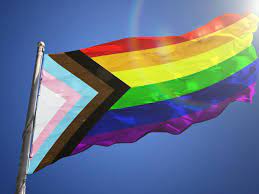
Drop-in Centers
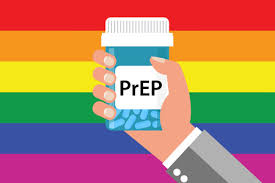
Another drop-in center LGBTQ youth can go to is Boston GLASS (Gay & Lesbian Adolescent Social Services). Boston GLASS caters to LGBTQ people of color ages 13-29 and offers HIV/STI testing, PrEP access, as well as sexual wellness counselling. Additionally there is virtual or in-person therapy, in-home family therapy, and therapeutic monitoring offered. Similar to BAGLY, youth do not need insurance to receive services as all GLASS services are free. Youth can also attend a variety of social groups and events hosted by GLASS that cater to different interests and needs of the LGBTQ youth community.
Other Community Resources
One resource that serves both youth and their loved ones or caretakers is Greater Boston PFLAG (Parents, Families, and Friends of Lesbians and Gays), where folks receive support and education around their/their child’s sexuality or gender identity. These support groups are run by parents of LGBTQ youth or adults and take place across Massachusetts. They also have a helpline people can call for resources and to have their questions answered if they cannot attend an in-person support group.
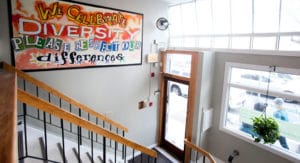
The Sidney Borum Jr. Health Center
A favorite for healthcare across the local LGBTQ community, The Sidney Borum Jr Center in Boston provides mental health counseling, support groups for transgender youth and adults, substance abuse treatment, STD testing and treatment, and medical care. The Sidney Borum Jr Center takes most insurances.
Finally, a virtual resource LGBTQ youth can access across the country is The Trevor Project, which has a helpline folks can call for support, as well as a text line and an online chat room they can use if they aren’t able to make a phone call. The chat room has a private feature that enables the user to close the tab with three taps of the “esc” button if they cannot show their family their computer screen for safety reasons. The Trevor Project also has online chat rooms that LGBTQ youth can use to connect with each other.
These are not the only services available to LGBTQ youth in Massachusetts. There are a lot of organizations able and ready to serve the extensive and varying needs of LGBTQ youth, and we encourage you to reach out for either yourself or someone you know if you need it.
Links to These Resources
BAGLY
Boston GLASS
https://jri.org/services/health-and-housing/health/boston-glass
(857) 399-1920
Greater Boston PFLAG
(781) 891-5966
Sidney Borum Jr Health Center
https://fenwayhealth.org/info/locations/the-borum/
(617) 457-8140
The Trevor Project
https://www.thetrevorproject.org/
(866) 488-7386
The NAN Project’s End of Year Recap
End of Year Recap
The NAN Project team has been super busy this school year with our Peer Mentor presentations, professional development trainings, and parent presentations. Since the beginning of this school year, we have presented for 16 schools to over 1,350 students and 770 caregivers, parents, and community stakeholders. That’s a total of 2,120 folks! While most of our presentations were to high school students, we really expanded our audience this year with a successful rollout to middle schoolers and parents. We recently finished up a round of presentations at Beverly Middle School and their students were so excited to talk with us. They asked our Peer Mentors questions about their stories and shared their own experiences and coping strategies. The conversations were enriching for both the students and our team. Check out what Beverly’s teachers had to say about us:
“Speakers were fantastic, love the new addition of the self-care kahoot, great education around strategies to help.”
“I thought it was great. Super well organized. I loved that you had 3 speakers and I think it was 3 others as well [to answer students’ questions]. It felt like you set it up for safe conversation. The speakers chimed in when students were more quiet making it conversational. “
What Does a Typical Middle School Presentation Look Like?
Three of our Peers present their COVID Comeback stories,which talk about how their mental health has been affected during the Pandemic and what strategies they are using to take care of themselves. Between each Comeback Story, we have a discussion with the students about warning signs they noticed in the story, the importance of reaching out to a trusted adult, and different self-care activities they could try. Every class has a guidance counselor come in to talk about their role and the mental health resources available in the school, so students know they have a trusted adult available if they need to talk. We’ve added a self-care Kahoot, which is a virtual trivia game , to engage students and make presentations more interactive.
Parent Presentations

We’ve also had big turnouts and lots of positive feedback about our parent presentations! Because we are doing everything virtually this year, our trainings have become a lot more accessible for busy parents. Schools have told us that parents they haven’t had any contact with all year have come to our events. One of our popular trainings is called Building Resilient Families, where our knowledgeable trainers go over different strategies to help families adapt to challenging situations and bounce back. We also provide many resources including hotlines and websites with mental health information. Since parents and families are a really important source of support to young adults, we are so happy that we’ve been able to connect with them more in the past few months.
We look forward to continuing our work in the New Year. We hope everyone has a healthy and safe holiday season!
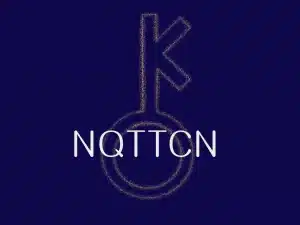 ★ National Queer and Trans Therapists of Color Network:
★ National Queer and Trans Therapists of Color Network: 
